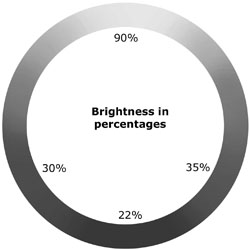How to Choose Colors Everyone Likes

This article is courtesy ColourLovers.com.

More than half a century ago, Aemelius Müller, professor at the academy of Winterthur, Switzerland, came up with a formula that could predict the appreciation of a color-combination. In other words: Müller was able to predict which combination of colors most people would probably like.
Müller’s formula predicts that these color combinations will be considered ugly by most people:

While these will be liked. How is this possible?

First we need to consider the “natural” brightness of the colors of the color circle, as discussed in this post about Brightness vs. Whiteness. You will notice that yellow, for instance, is a lot brighter than blue in the image below.

On a scale from 1 to 100, bright yellow has a brightness value of 90, while bright blue has a value as low as 35. Likewise, every hue in the color circle has its own “natural” brightness.

Take the combination below. All three colors have the exact same hue of blue. The only difference between the colors is their brightness.

Now pair the last combination with the “ugly” combination on the left and the “nice” combination on the right:

See what happened? Toward the “ugly” (left) side the dark blue shifted to a greener hue, while the bright blue shifted to a more purple hue. This is contrary to the “natural” brightness of the colors. After all, if you check the color circles you will see that green is much brighter than purple. Toward the “nice” (right) side the dark color shifted to purple while the bright color shifted to green. This shift is in accordance with the “natural” brightness of the colors.
The same goes for the red combinations. Toward the “ugly” side the colors shift contrary to the “natural” brightness, while on the “nice” side they shift in accordance with the natural brightness:

So here’s the simple formula: If a combination follows the natural brightness of colors, most people will like it. If a combination contradicts the natural brightness of colors, most people won’t like it.
There is some dispute in academia whether or not to interpret the “nice” color combinations as good taste; the obvious implication being that the “ugly” combinations are of bad taste. I myself tested the formula on many occasions when lecturing a group of people. It never fails and it’s always fun to confront people with the predictability of their taste. But I also noticed that people in creative professions, such as artists or designers, often tend to like the “ugly” combinations. Because people in this group often lay claim to good taste, in my opinion the taste hypothesis doesn’t hold. As far as I’m concerned no one can lay claim to good taste. People like it or they don’t. Good or bad taste is a non-issue.
However, while Müller’s formula may not determine the difference between good or bad taste, it sure does predict common taste. And that makes the formula quite useful for any designer.
Igor Asselbergs is a color professional and currently CEO of Colorjinn. He writes his own color blog at Livelygrey.com.
This article was last modified on July 11, 2023
This article was first published on March 30, 2009



